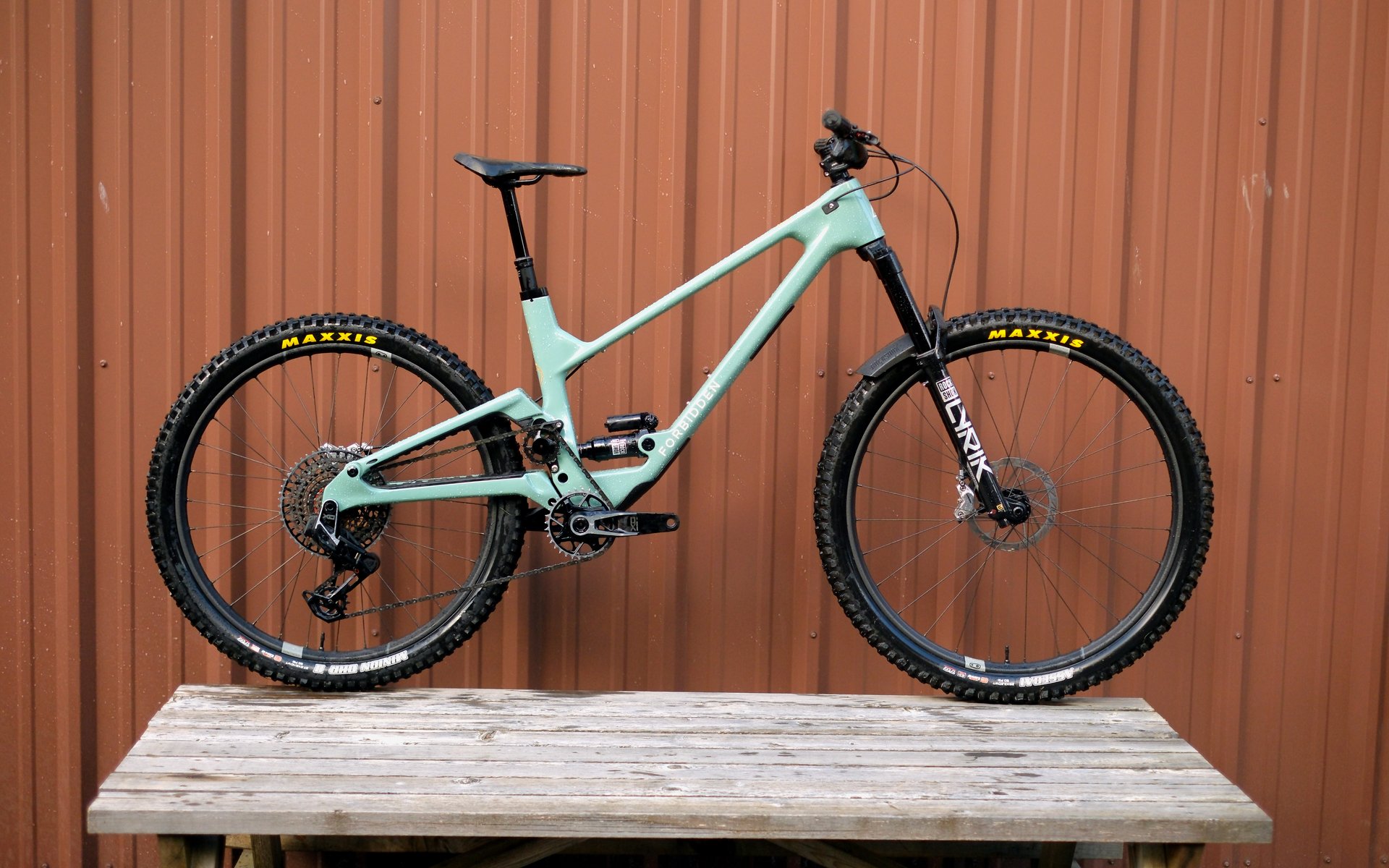
Ridden and Reviewed
Introducing the Forbidden Druid V2
Only four short years ago, Forbidden Bikes launched their first bike: the Forbidden Druid. I remember really enjoying the original Druid, and thinking Forbidden was going to struggle to keep bikes in stock. In the last four years Forbidden has forged their own path, proving that high pivot trail bikes can work. After the Druid, Forbidden released the 154 mm travel Dreadnought in 2021, which if you don't remember, was in the middle of a global pandemic. A few weeks ago Forbidden flew me out to Cumberland for their first hosted launch to test the all new Druid V2.
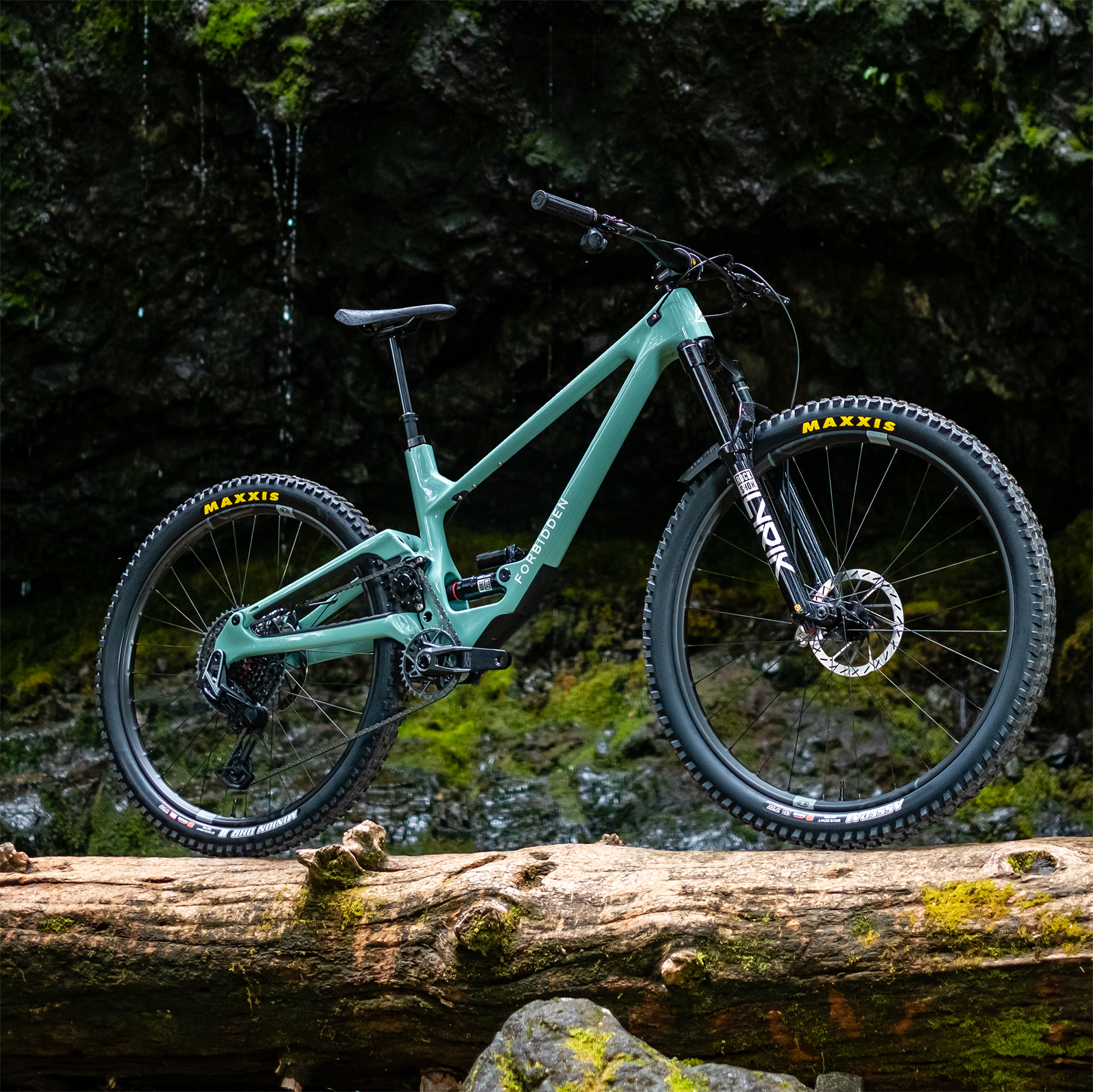
The new Forbidden Druid V2 in the "Spruce Almighty" colour way.

And the Druid V2 in the Stardust colour way.
The Druid V2 keeps the same 130mm travel and idler pulley from the original Druid, and that's about it. The Druid V2 now uses an inverted four bar layout, as opposed to the old Druid's linkage driven single pivot layout. The geometry is updated, and it's also available in a mixed wheel size configuration. While Druid V2 is an all new bike, using a new suspension platform, Forbidden claims the Druid V2 is an evolution of the Druid.
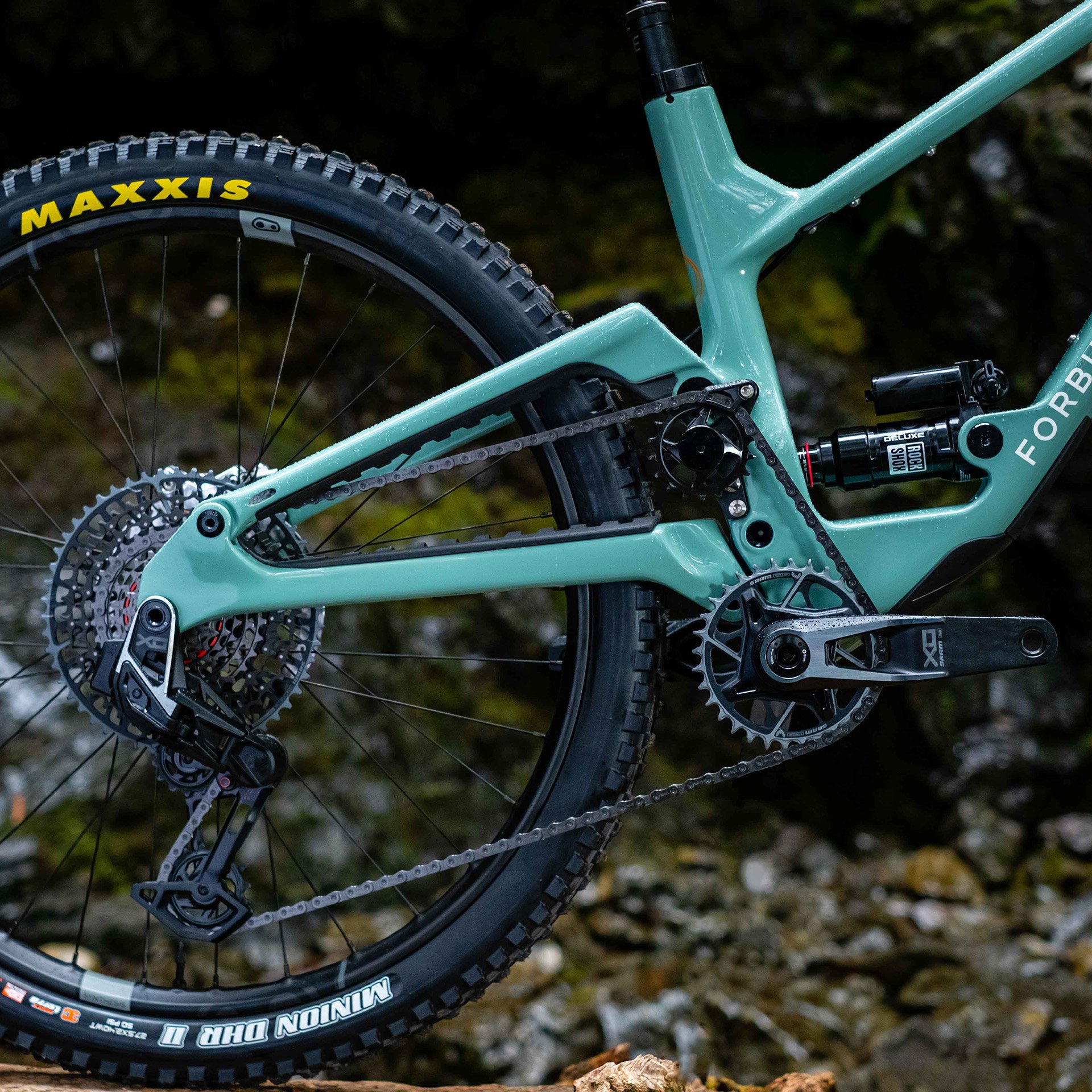
While the backend of the Druid V2 is all new, the design language is clearly Forbidden.
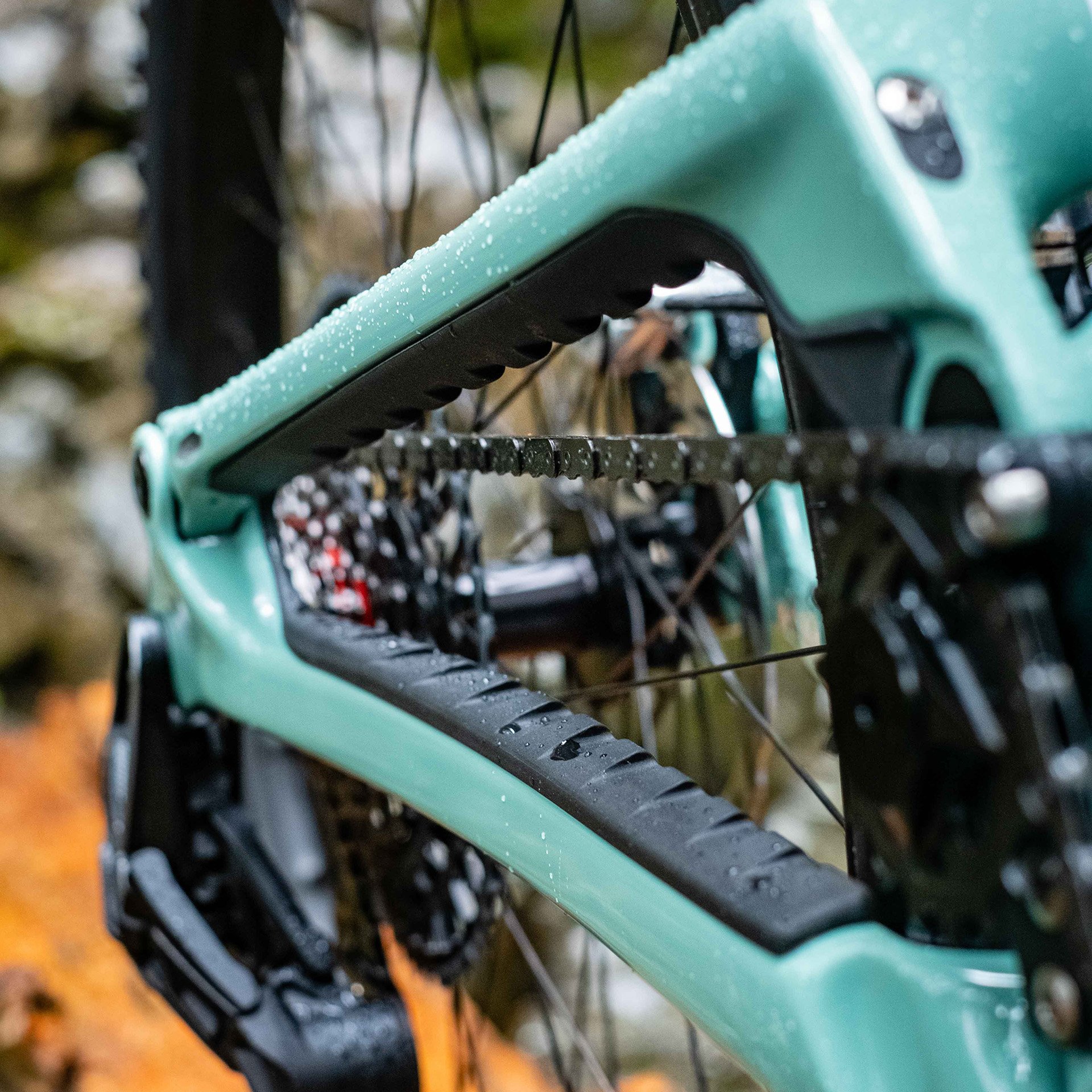
The chain slap protection is well done on the Druid V2, resulting in a quiet ride.
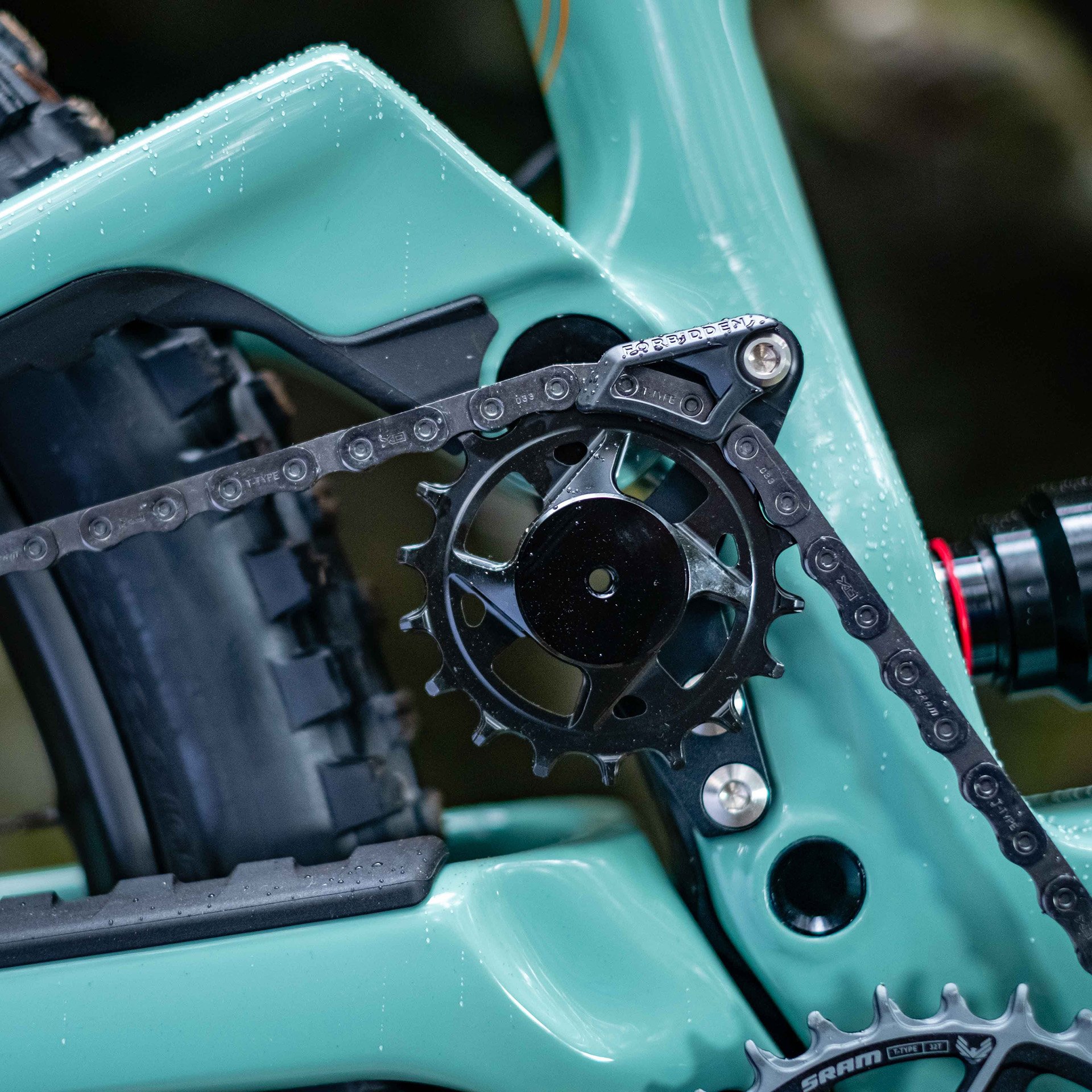
Forbidden has done a lot of work to improve their idler pulley to have the optimal material, coatings, tooth profile, bearings and angle to the chain line to provide a quieter ride and longer lasting drivetrain.
Druid V2 Highlights
- 130 mm travel carbon frame, designed around a 150 mm fork
- 29 inch wheels or mixed wheel configurations
- 65° Head Angle in 29er trim // 64.5º in mixed wheel trim
- Size Large (S3) wheelbase is 1,259 mm with a reach of 480 mm
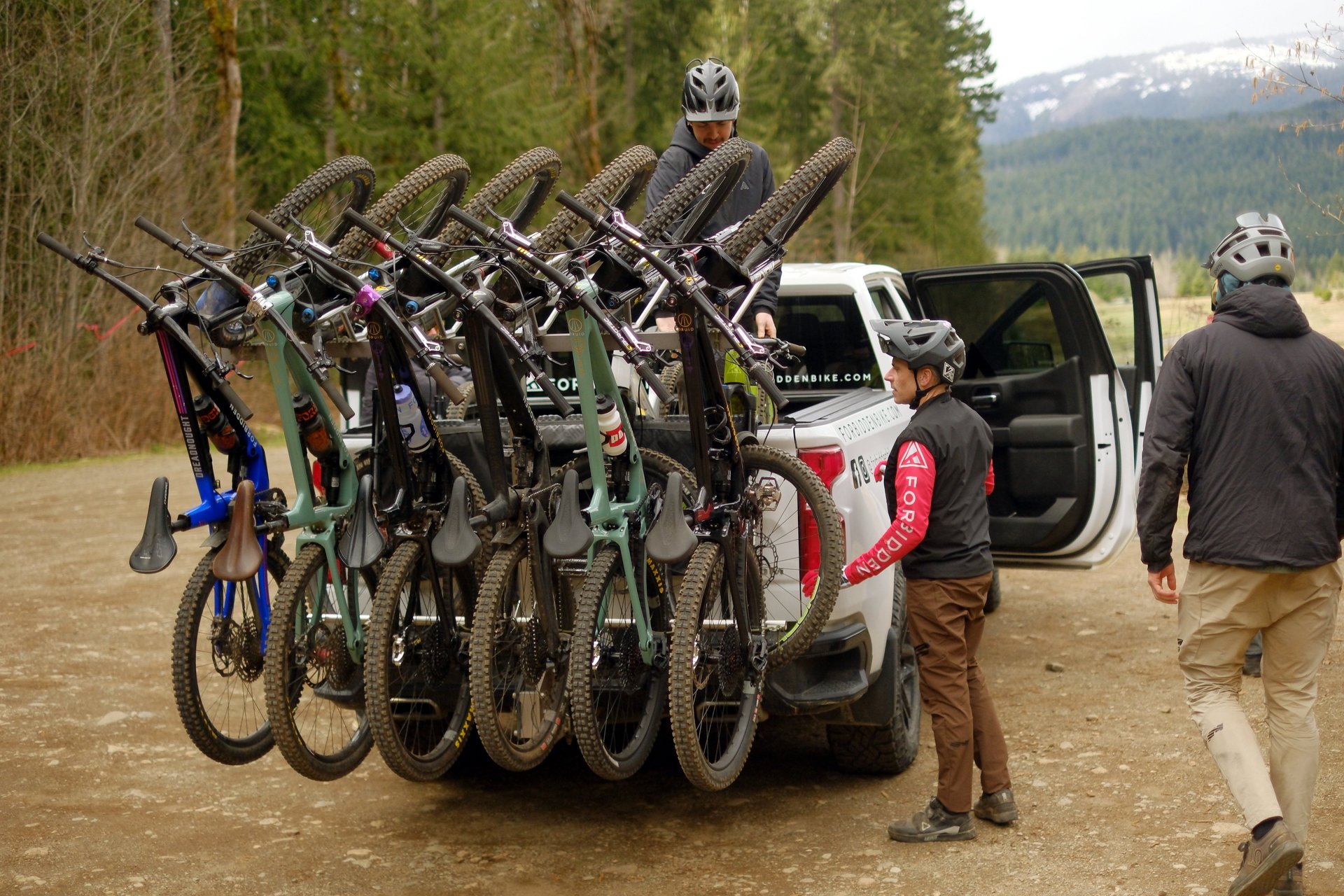
In order to get some time in on the Druid V2 ahead of the launch date, Forbidden had us over to Cumberland to try out the new bike on their local trails.
Druid V2 Geometry
Forbidden hasn't strayed far from the original Druid's geometry. The character of the bike remains, with one larger size now available. The head angle is slightly slacker at 65°, and the seat tube is slightly steeper, too. The Druid V2 is available as a mixed wheel bike, and in that configuration the head angle drops to 64.5°.
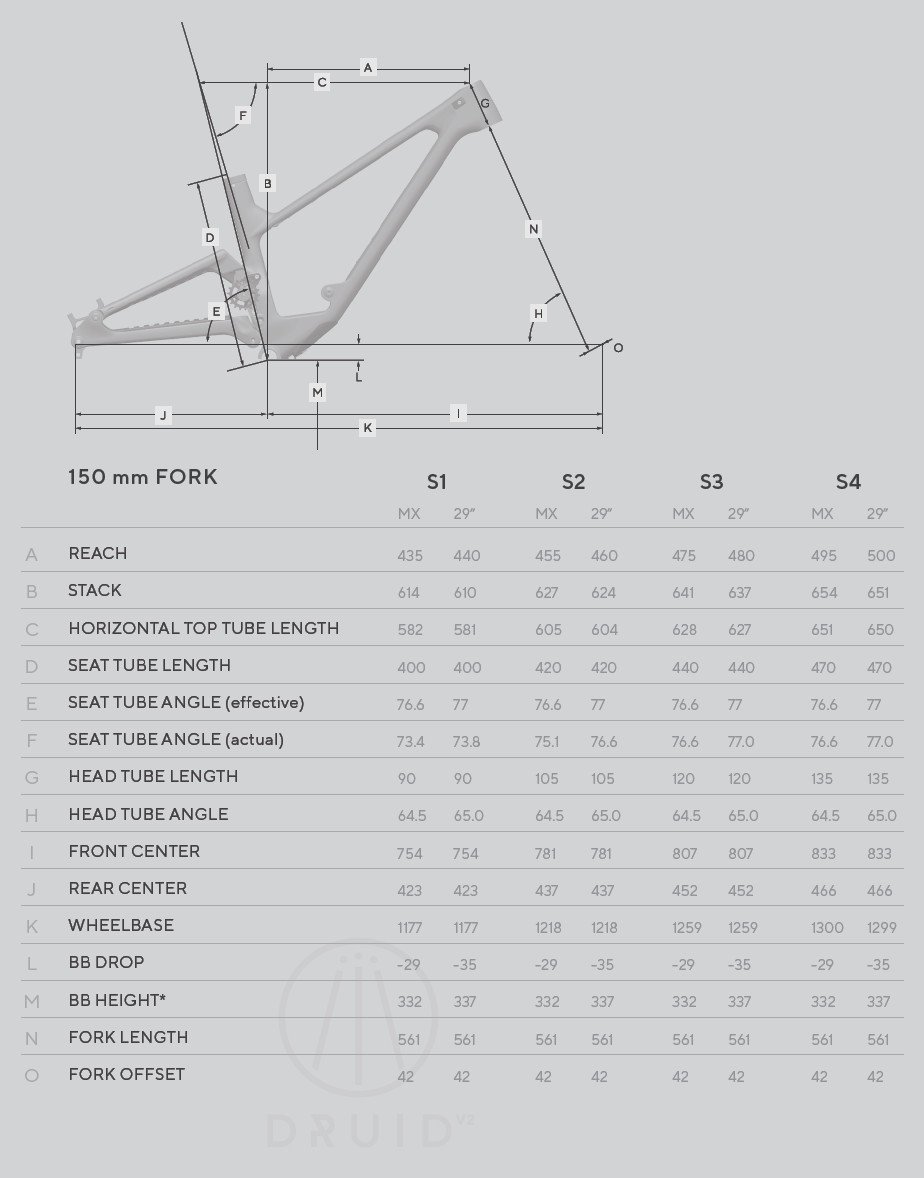
One area that is unique with Forbidden's bikes, and the Druid is no different, is that the rear center scales proportionately with the wheelbase of the bike. This means that all sizes of the Druid have the same ratio of front center to rear center. While the S1 and S2 sizes come with relatively standard rear centers, the S3 and S4 bikes come with unusually long rear centers. In the case of the S4 Druid V2 the rear center is 466 mm static, and grows to 478 mm at sag, which is quite a bit longer than any other bike I'm aware of on the market.
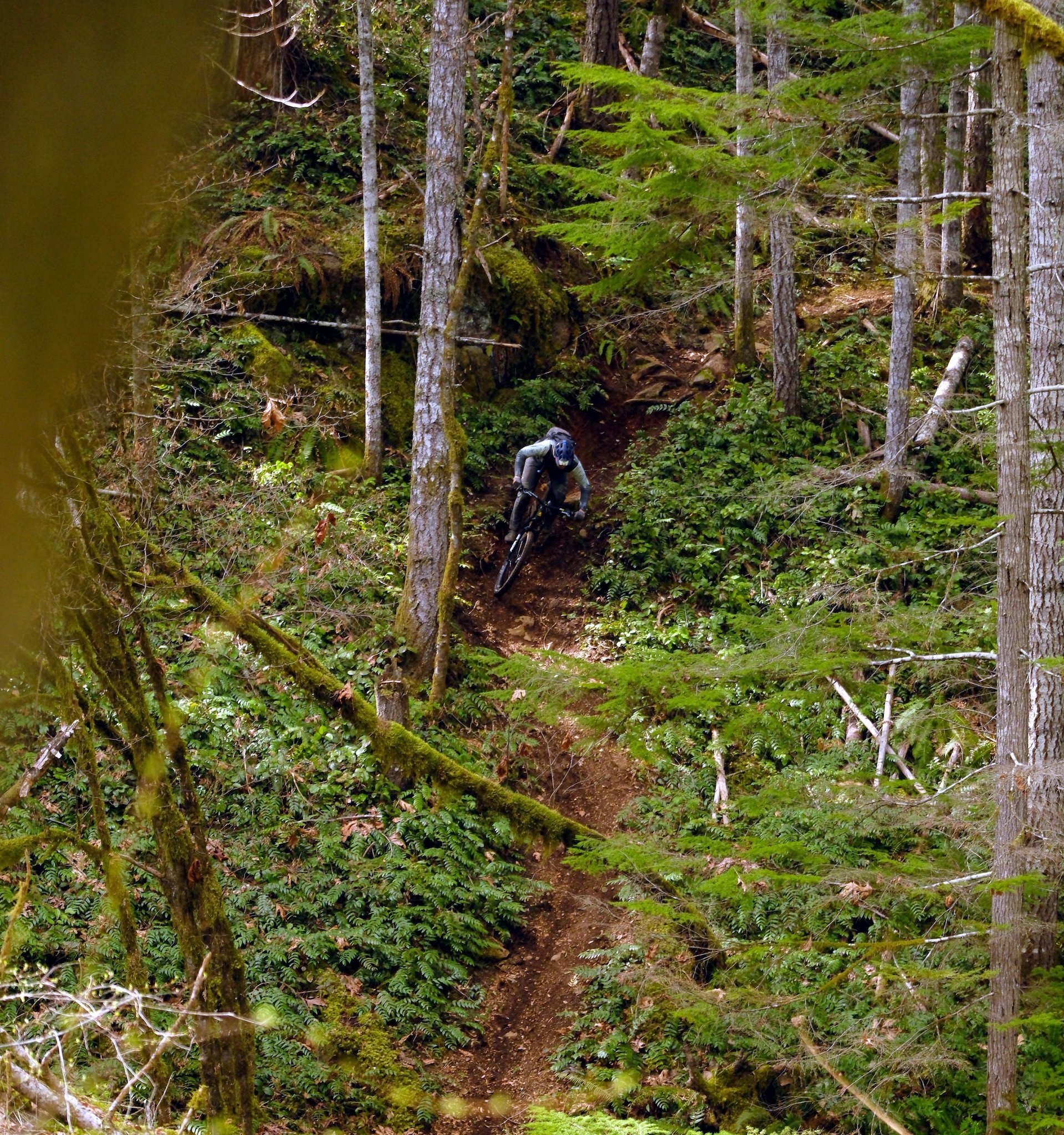
Cumberland is a beautiful place to test out a new bike.
Suspension
Although the suspension platform has changed for the Druid V2, Forbidden are adamant the Druid V2 is an evolution. This rings true when looking at the geometry chart or the overall look and feel of the Druid V2: it's very Druidy. So then, why the change in suspension platform? Forbidden explained that one of the key areas they wanted to improve with the Druid V2 was chain retention on the ring so they could eliminate the complexity and friction of the lower chain guide. As catalysts go, that's not one I would have predicted, but it makes sense. By working through a number of iterations of an inverted four bar, Forbidden was able to package the idler further back in the frame, and fixed to the front triangle, which they believe solves the chain retention issue without needing a lower chain guide. The inverted four bar's characteristics provide improved braking performance deeper in the travel, and the slightly less rearward axle path were side benefits. I've spent a ton of time on an inverted four bar bike and think it's an architecture that makes a ton of sense.
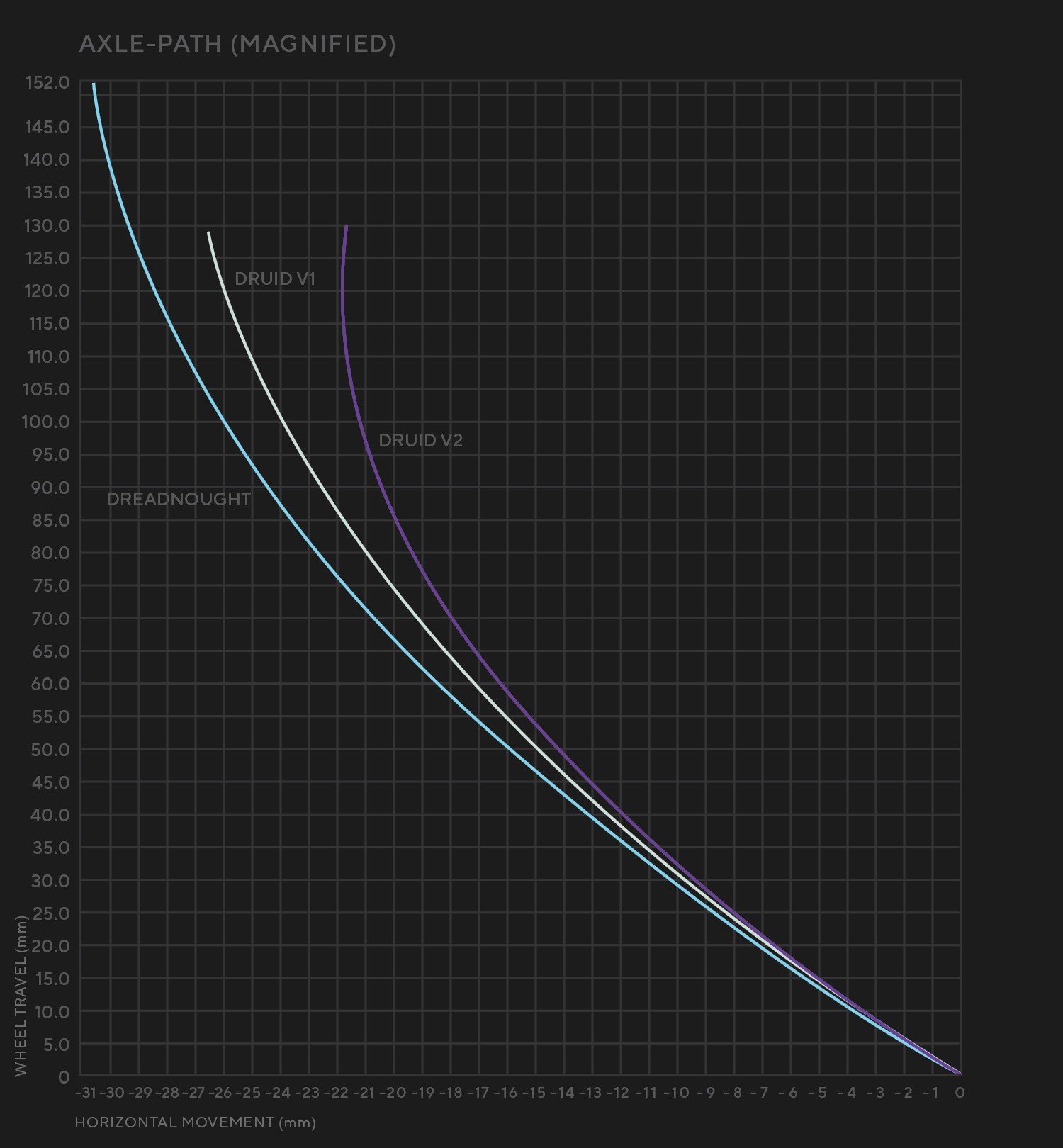
The Druid V2 axle path is still rearward throughout the travel, but less so than the original Druid.
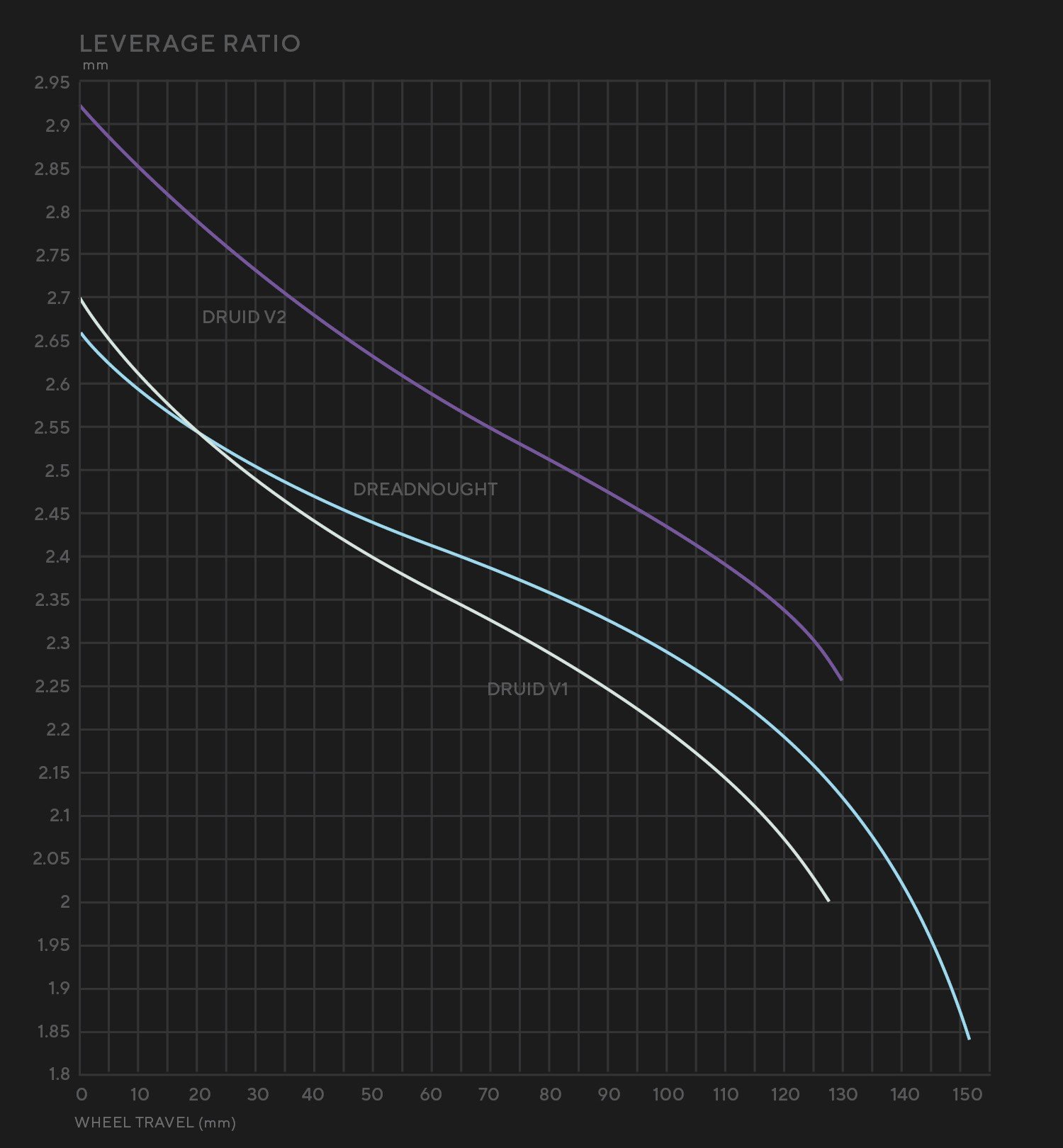
The leverage curve's shape is almost the same as the original Druid, but shifted up a bit to be more accommodating to lighter riders.
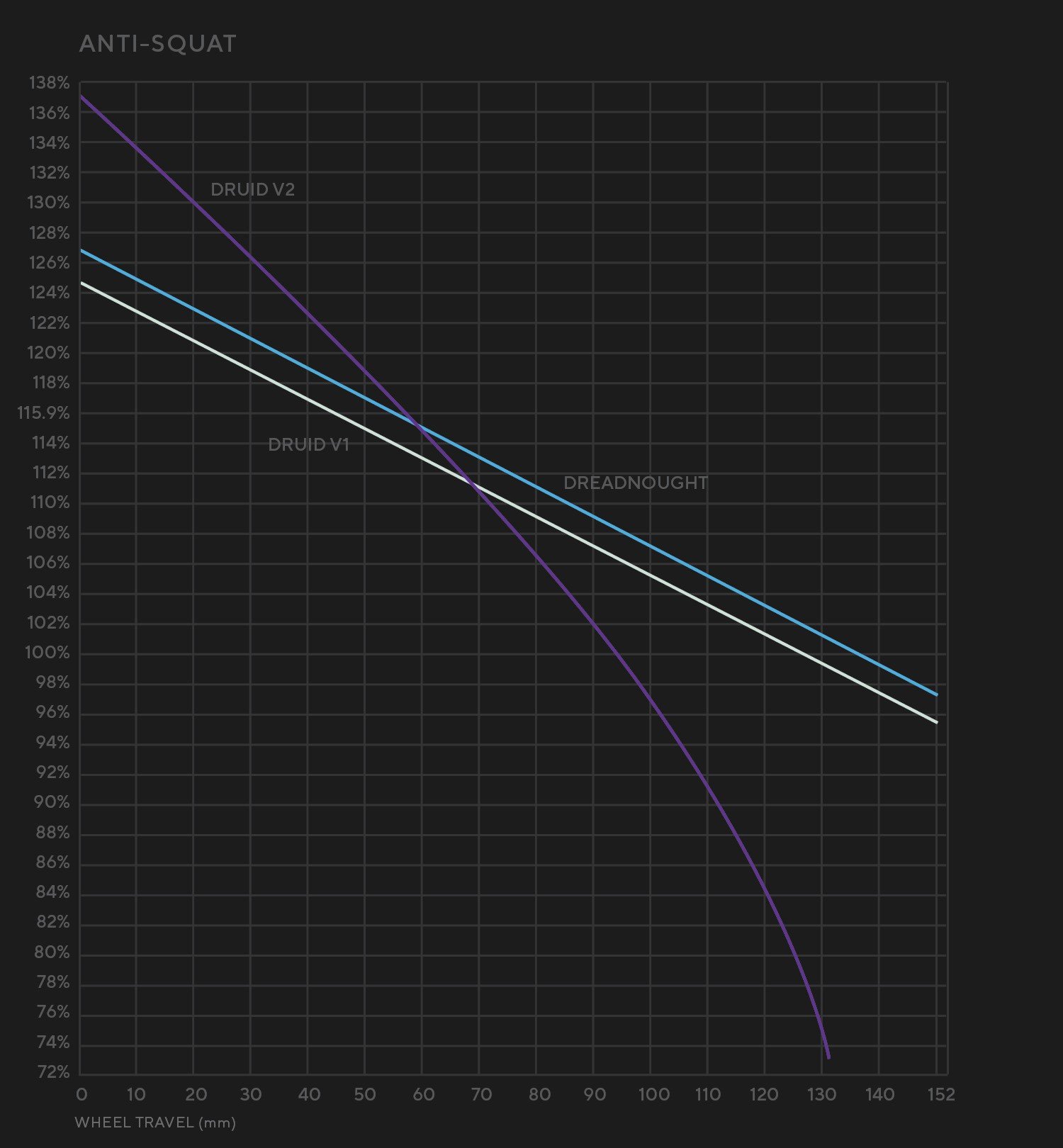
Slightly more anti-squat than the original Druid makes the Druid V2 pedal firmly around the sag point.
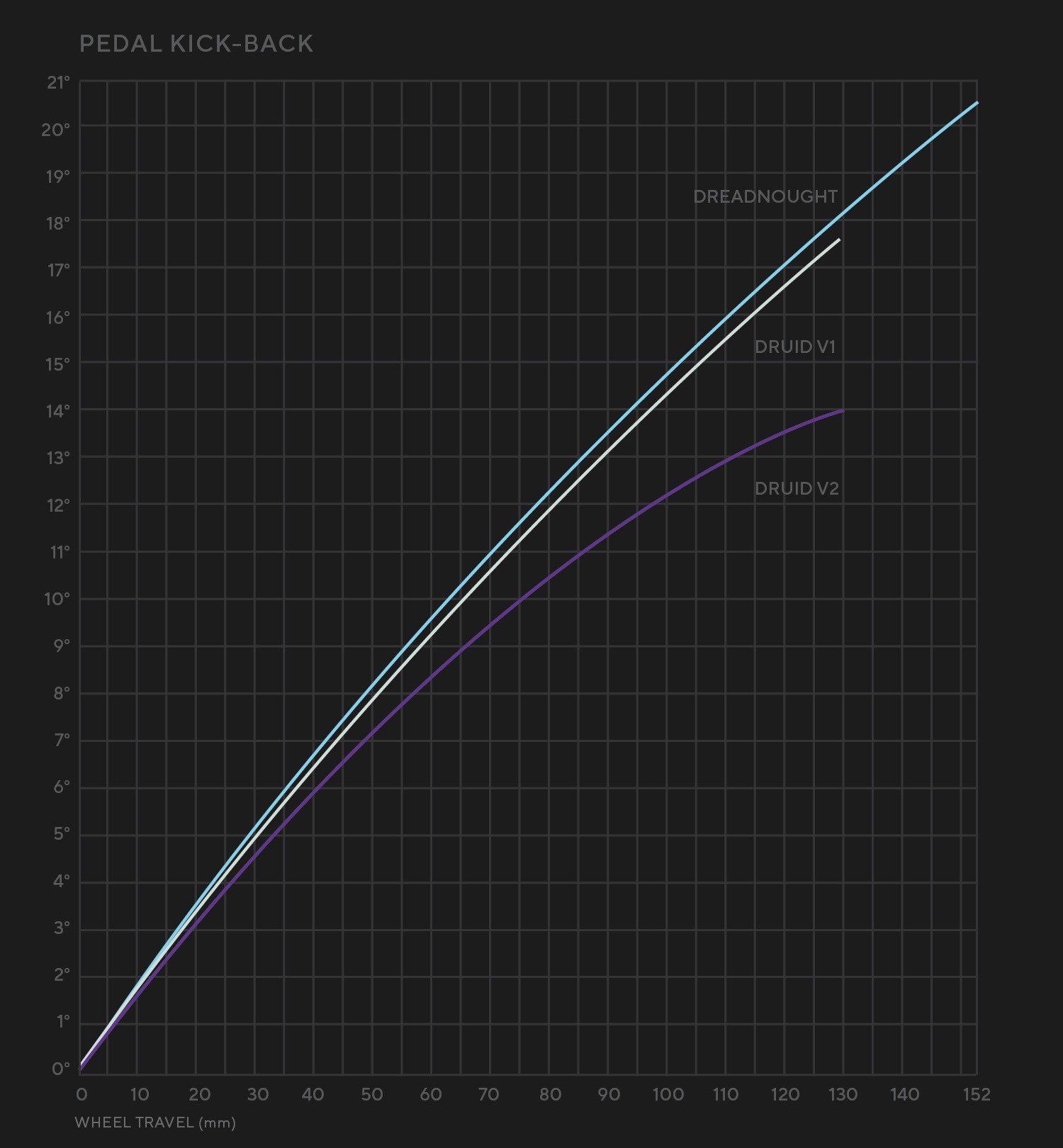
The lower anti-squat means less pedal kick back deeper in the travel.
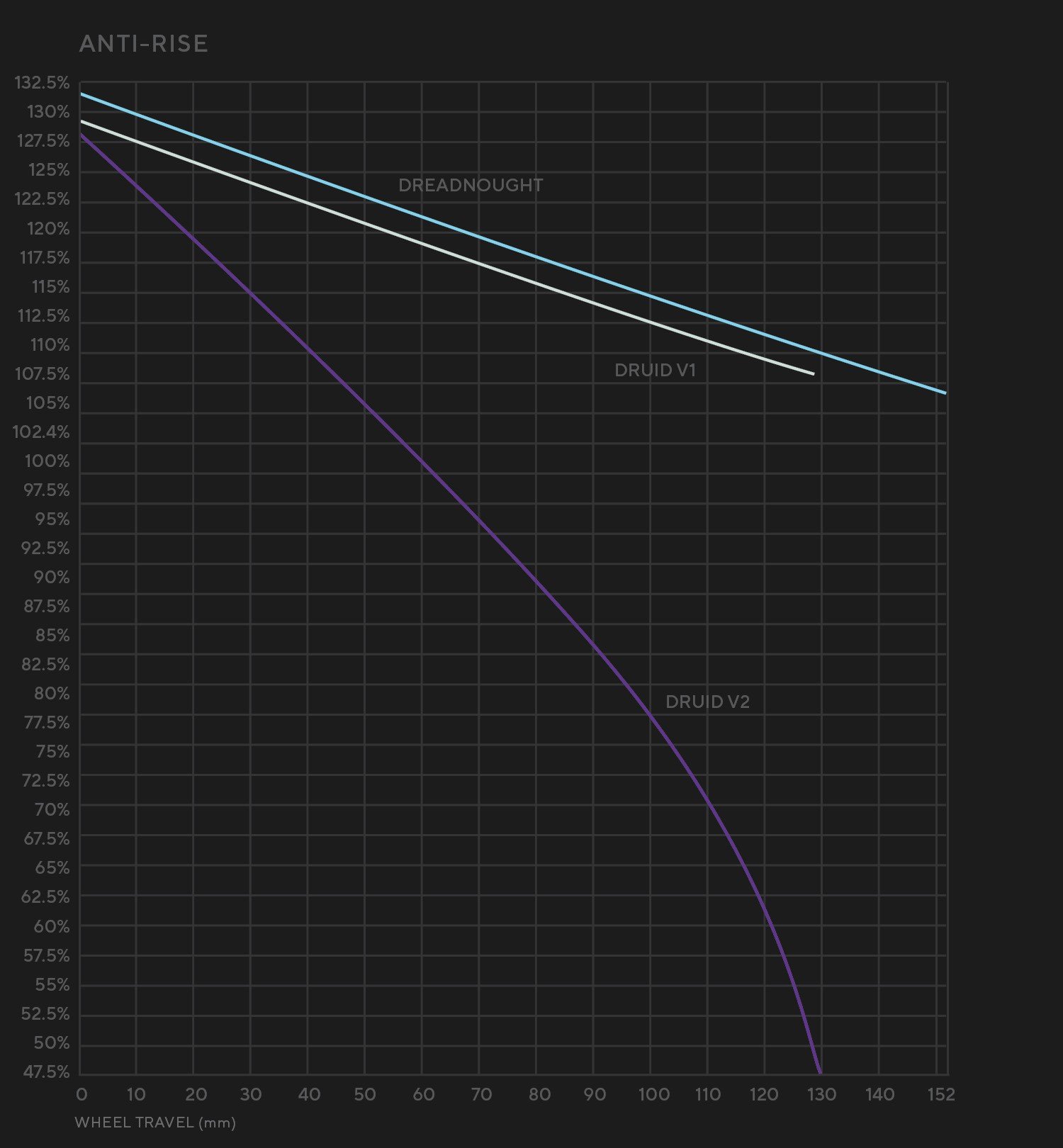
Forbidden claims they like the amount of anti-rise the old high single pivot bikes create at the start of the travel. This effect helps compress and stabilize the chassis, but it quickly falls to prevent the excessive brake squat some high single pivots are famous for.
Frame Details
Forbidden has put an impressive amount of time and thought into the new Druid V2. One of the best examples of this is the variety of idler pulley mounts that come with the framekit to optomize the idler pulley location to the drivetrain spacing. For the newer 55 mm chainline T-Type drivetrains Forbidden slightly angles the idler pulley to improve drivetrain efficiency, reduce chain wear and minimize drive train noise.
The Druid V2 is available as a mixed wheel size setup or full 29er by changing the chain stay. The cable routing and frame protection pieces look well made, and fit visually with the bike. There is now a small storage volume under the rear shock that is accessed by a subtle quarter turn knob.
The Druid V2 is similar in silhouette to the original Druid, and that's not an accident. Forbidden wanted the Druid V2 to clearly be a family member of the original Druid. I don't think this is a mistake either. The Druid V2 is a beautiful bike, with smooth, cohesive, flowing lines throughout.
Both of the colours available in the Druid V2 are gorgeous, but I'd personally go for the green one.
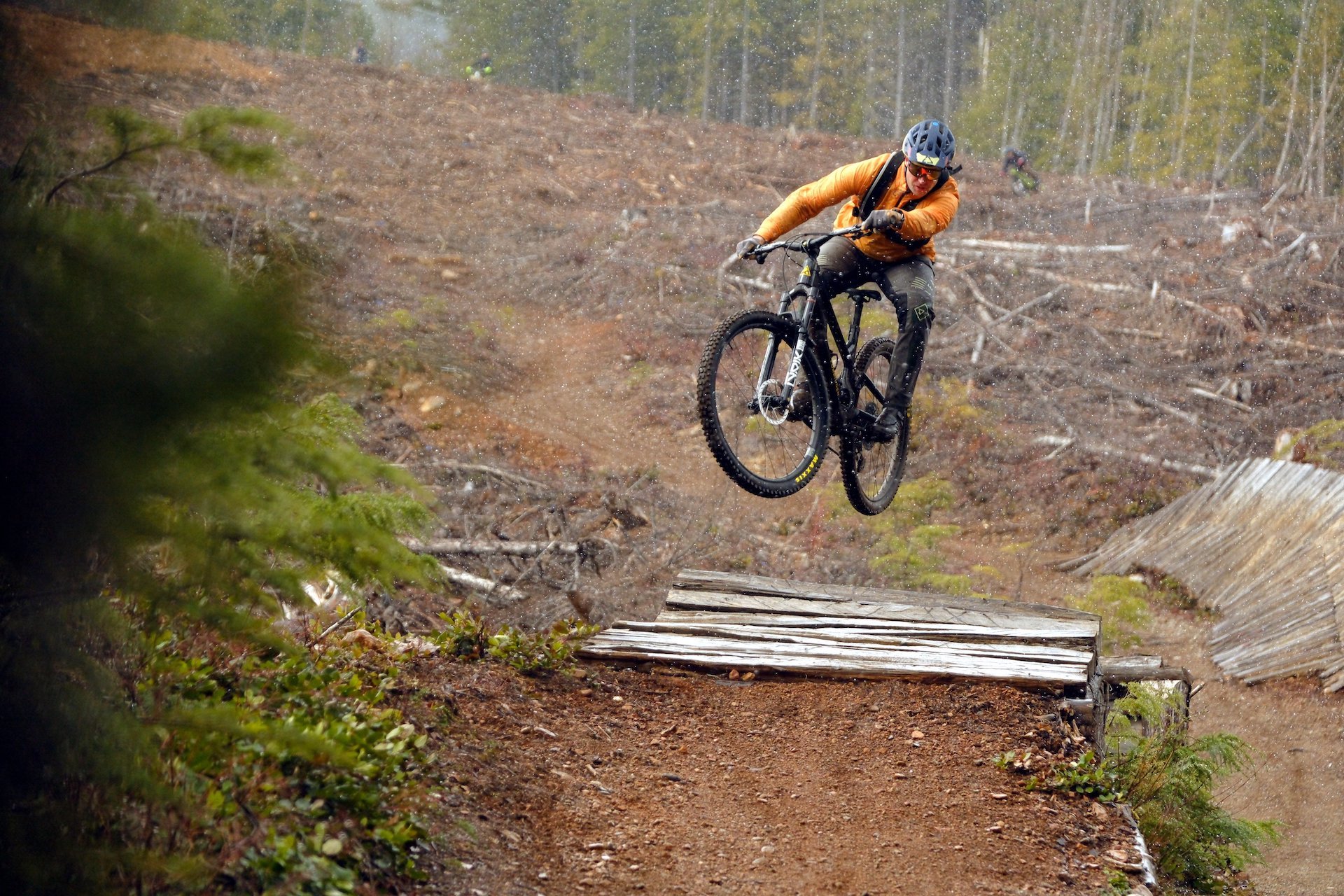
Mother nature attempted to spoil the launch party with some snow, but we were still gonna send it.
Builds and Pricing
The new Druid V2 is available as a framekit or as a complete bike. All complete bikes from Forbidden will come with AXS drivetrains, with the GX AXS available as a RockShox or Fox suspension build. Before the luddites get their undies in a twist, there are ports in the frame for cable actuated peasant shifting.

While the Druid V2 isn't cheap, I think the pricing is reasonable in comparison to higher end bikes on the market when you consider the quality of the frame and builds on these bikes.
Riding Impressions
These press trips can be hard. We often have to get the bikes set up in a short period of time, and then have a few hours of ride time to get the bike dialed in, generate some impressions, and take some riding photos. I initially felt a bit awkward on the Druid V2. I haven't ridden the new Lyrik, nor have I ridden many 130 mm travel bikes since the last Druid I was on, and haven't ridden a harder compound front tire in eons. Strangely I felt like I was struggling to turn the bike. This could have been due to the tight trails in the Cumberland area we rode first. So I made some changes to the bike, mostly to increase the shock pressure, which seemed to help. 220 psi in the shock gave me 30% seated sag, which balanced nicely with 100 psi in the Lyrik. The increase in shock pressure, and an adjustment to my riding style got me to a comfy place with the Druid V2. In retrospect, the Druid V2's relatively long rear centre took me some time to adjust to for my riding style.
Initial climbing impressions are that the Druid V2 is efficient and firm, even with the shock climb switch in the open position. This is truly a bike that doesn't need a climb switch. Technical climbs were surprisingly easy with firm pedaling characteristics, supple suspension, longer rear center and forward seated position. I was surprised at the difficulty and steepness of sections I was able to pedal the Druid V2 up. Much of Forbidden Plateau has short descending sections, punctuated by steep and punchy technical climbs. A bike like the Druid V2 that doesn't rely on a climb switch for pedaling efficiency is great here as you can just ride and not think about switching shock modes as you transition from uphill to downhill and vice versa.
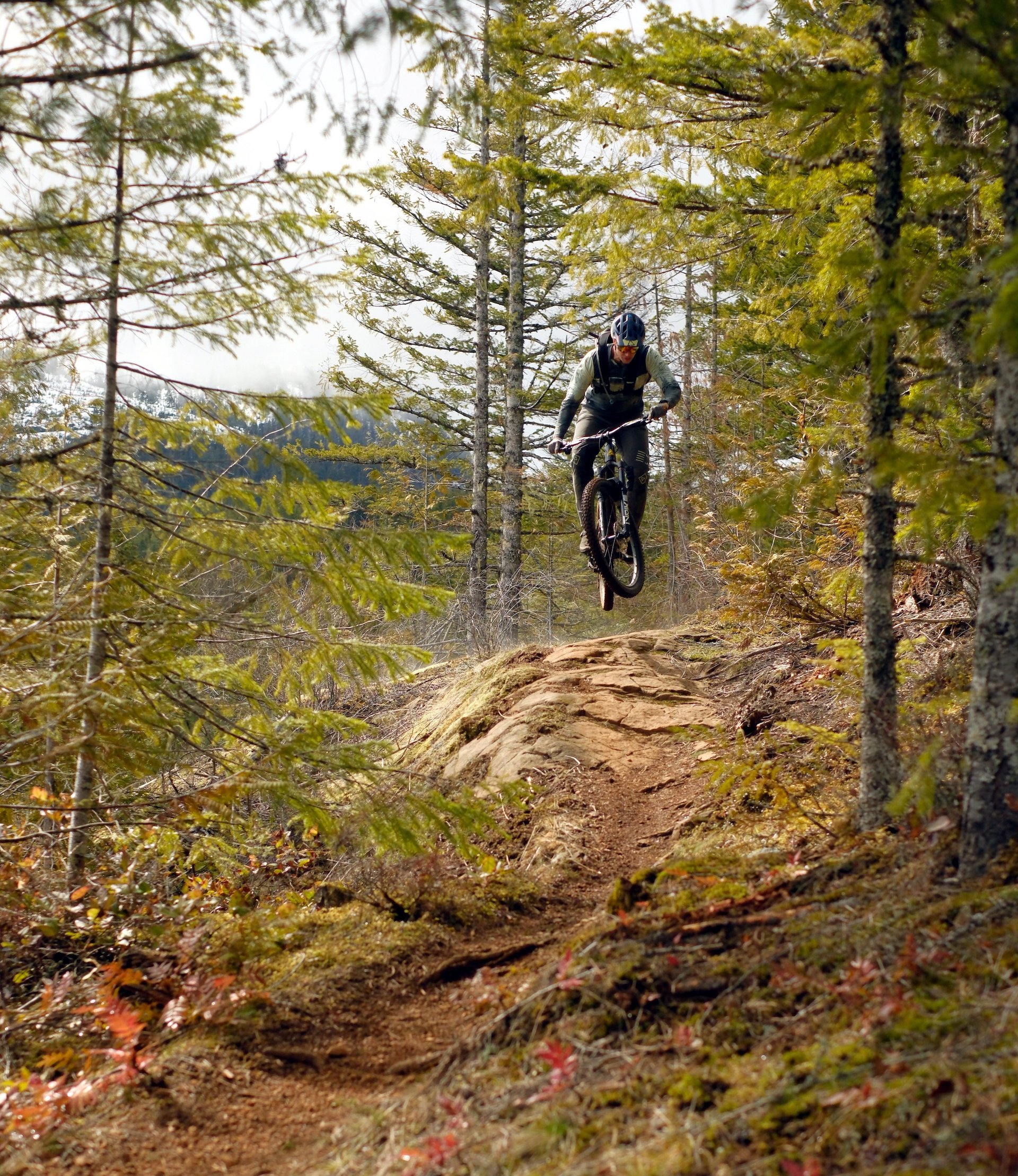
The short wheelbase, light weight and supportive platform means the Druid V2 is a pleasure to get airborne. I thoroughly enjoyed pulling for natural gaps littered all over the busy trails around Cumberland.
Once we started descending, the first thing I noticed was how quiet the Druid V2 is. Forbidden has done a great job at managing the chain slap, and protecting the frame where necessary with soft materials to damp the impact. I was impressed with how polished the original Druid was as Forbidden's first production bike, and they've taken that level of frame finishing and details even further with the Druid V2.
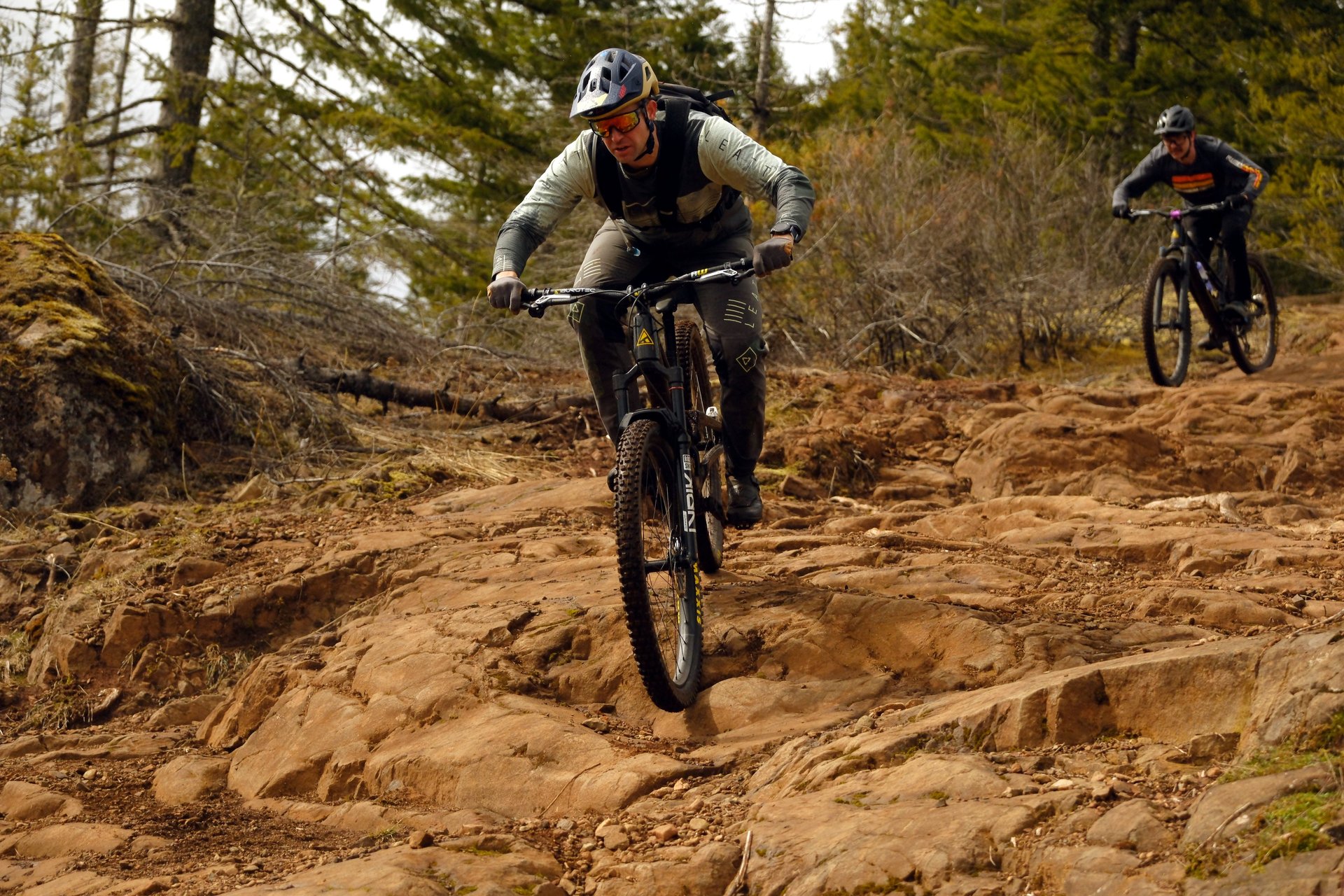
The Druid V2 shines on these chunky trails.
The longer rear center of the Druid V2 gives the bike a surprisingly planted and stable feeling but this comes at a cost and getting the Druid V2 to change directions takes a bit more effort. It took me more time than most bikes to adapt to the dichotomy of a steeper head angle, shorter front center, and longer rear center. Particularly on the S3 and S4 sizes, the rear centres are much longer than most other bikes on the market. Some riders will love the stability it brings to the bike, while others may find the Druid a bit more difficult to turn and manual.
The Druid V2's suspension platform was impressive through the constantly chunky trails of Forbidden Plateau. While the V2 doesn't have gobs of travel to eat huge impacts, it makes excellent traction through rocky and rooty sections. It has this strange combination of a supportive, snappy shorter travel bike, with excellent suppleness over chunky terrain. So while the short travel of the Druid V2 kept me on my toes, I came away impressed with how it tracked over rough trail.
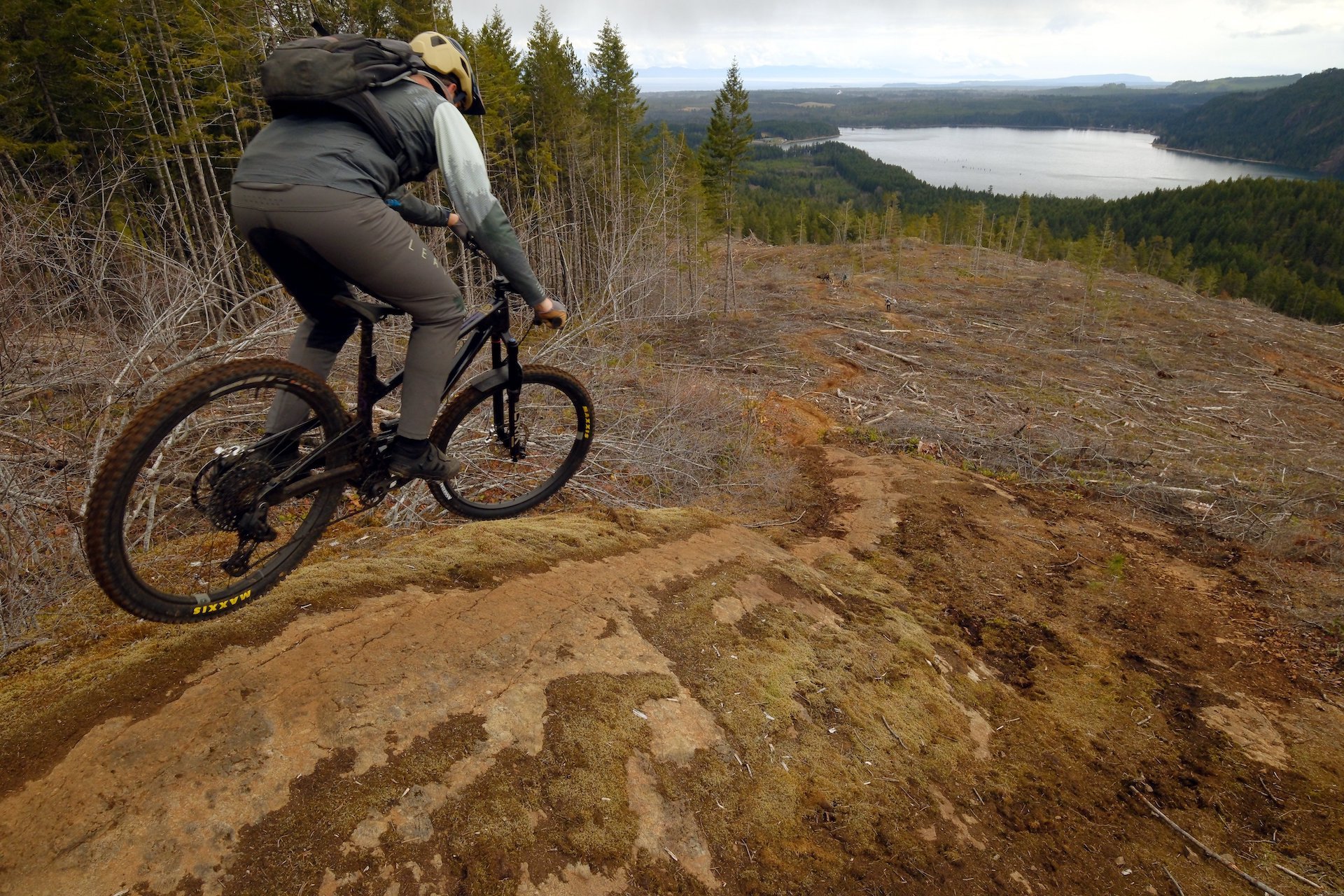
Feeling comfy on the Druid V2 I pulled for this gap on Fobidden Plateau, without knowing what was coming up.
The new suspension architecture of the Druid V2 makes a ton of sense, and is a step forward for Forbidden. From the short test rides we got in, it provided a firm and efficient pedaling platform, while still being supple and active descending. While it took me some time to adapt to the longer rear center of the Druid V2, it is a fun, snappy 130mm bike that is far more capable than the relatively short travel suggests. For taller riders, the rear center on the S3 and S4 is probably longer than anything you've ridden, which will take some getting used to. Forbidden's attention to detail on the Druid V2 is excellent, I think it's a beautiful bike with all the features one could ask for. Pricing is reasonable, too. All in all my first impressions leave me thinking the Druid V2 is a fast, fun and capable trail bike.
Age: 41
Height: 183 cm / 6'
Weight: 87 kg / 192 lbs
Ape Index: 1.055 / +10 cm
Inseam: 81 cm / 32"
Preferred Riding: Gravity Mountain Bike
Bar Width: 800 mm
Preferred Reach: 500 - 520 mm (but this is stack and head angle dependent)
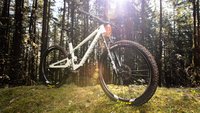


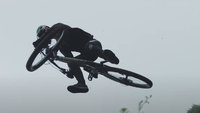







Comments
Lu Kz
11 months, 2 weeks ago
Hmm. The V1 Druid was on the prettier side of bikes I've ever seen. The high single pivot gave it such a sleek silhouette which the new linkage and rear end has lost... The V2 reminds me a bit of some of GT's iterations of i-drive. Not having touched one, the finish looks great, but some of the magic (or, using Forbidden's words, the Witchcraft) is gone.
I'm sure it's a good update. I know quite a few local riders whose main complaint is that the midstroke wasn't there with the Druid, and the increased-over-the-board curve of the new bike is probably a big upgrade in that department, especially for a 130mm bike that is meant to be charged hard AF. All the upgrades suggest it's a better bike to ride and own.
Having spent a lot of time on the current gen Range (also with upside-down linkage high pivot craziness) and Mr. Pemberton's first foray into the high pivot game, the Aurum HSP, I can imagine the suspension action under braking is indeed much improved on the Druid V2. However, I think the Aurum taught me to be a better rider in a short time frame when spending years on more forgiving bikes never did (the Aurum is a bit like an old-timey Catholic school teacher who will slap your wrists with the ruler when you screw up: "what are you doing dragging the brakes here?? Drop those heels and commit to braking or let the bike ride, one or the other - IDIOT!"). For the record, I still have the Aurum and don't have the Range, despite treating both as bike park bikes.
The Druid V1 would absolutely make it into my personal bike museum. I guess there's no possible iteration of the V2 that would get that honour, because the V1 is more important: with a few other examples, it showed the world this modern high pivot thing can work on bikes that aren't meant to have a chairlift, truck, or motor help them get to the top.
Reply
Kenny
11 months, 2 weeks ago
I'd agree. It's still a decent looking bike but it doesn't have the sex appeal the v1 had imo.
I think a raised chainstay just always reminds me of a dog peeing on a fire hydrant, like the old Marin mount vision or something.
Reply
Pete Roggeman
11 months, 2 weeks ago
"I think a raised chainstay just always reminds me of a dog peeing on a fire hydrant"
Love this.
Reply
MTBrent
11 months, 2 weeks ago
I'm gonna mark some territory later on my Orange.
Reply
Kenny
11 months, 1 week ago
Yes!
Reply
Pete Roggeman
11 months, 2 weeks ago
I don't disagree, but I think we also need to remember that when the V1 came out - FOUR years ago - it was one of the first high pivot trailbikes we'd seen (maybe THE first). So, our expectations were different, as were our frames of reference. If you think back over the history of this sport, there are very few examples of bike models that were able to consistently set the bar from both a performance AND an aesthetics standpoint. Even the Stumpjumper or the Enduro - two models that I'd say tread in 911 territory in terms of setting standards for those criteria - had some model years that were not big moves forward. It's almost comical to compare that behemoth to little Forbidden, but that's a testament to Owen and the team there.
It's so interesting, though, the relationship btwn looks and performance. Obviously personal in terms of opinion, skill, preference, and what we value. You could put 90% weight on looks and choose one bike, go 50/50 and choose another, and there would be others (racers for sure, but also many others) who would ride the ugliest bike ever and be happy about it as long as it was the fastest/lightest/strongest or whatever they most needed from a performance standpoint.
But I get it. The V1 Druid was a complete sensation and in a way, that kind of success from a company's first bike means the next one may almost certainly be a disappointment in some way. I suppose if the new one rides as much better than V1, which is what Forbidden intends (and Tim seems to think it's great) then that's a success, even if it won't be considered as iconic in the looks department.
Reply
Lu Kz
11 months, 2 weeks ago
Incidentally, the Enduro (the 2020, specifically in the rather rare granite) to also goes in my personal bike museum as both a beautiful and significant bike.
Forbidden caught lightning in a bottle with the first Druid, and to keep up those expectations for a V2 up, they had to do something - geometry changes don't cut it anymore when plenty of MTB commentary considers it closer to 'settled' than it has been in a long time.
When the Range was coming out to dealers, JJ (Norco FS product manager, I think is/was his title) dropped in at the store when his son was racing Sun Peaks - I asked about the Aurum HSP and how the Range was moving away from the 'single pivot' portion of the Aurum's design. He replied the main reason was the single pivot really limited their options as far as playing with variables in suspension design: too many things were instrinsically linked with too large an imapct on each other to tune it to a level they were satisfied with. I imagine the same is true for Forbidden between Druid 1 and Druid 2.
There's no criticism of Forbidden in my comment, or it shouldn't be interpreted that way, at least. Consider it a pining for the recent past, if you like.
Reply
Pete Roggeman
11 months, 2 weeks ago
100% agree about the Enduro incl that Granite graphic treatment, which was sick. Did not think you were being critical of the Druid and it didn't come across that way - I just thought it was also a commentary that was impacted by expectations, not unfairly, and HSP/HP bikes have gone from being mega exotic to reasonably commonplace in a short period of time.
I had a chat with Owen a few weeks ago and he told me the V2 was a chance for them to address some things they felt they could improve over the V1 (of course). We didn't get into it in specifics but part of that was due to the challenges of launching Forbidden's first ever bike and part of it was just that I'm sure he's learned so much about this style of bike over the years (has anyone done more HSP bikes than OP?) that you'd be surprised if he didn't have things he wanted to address.
Reply
hankthespacecowboy
11 months, 1 week ago
I've noticed a similar "Catholic schoolteacher" effect on my Dreadnought. Not so much on more rolling / flowy "modern" trails I tend to ride here in the States, but when we head to Oaxaca for steeper, / rockier / more "primitive" trails, the punishment for lack of commitment becomes very obvious. Dragging the brakes results in a uninterrupted ruler whacks to soles of my feet. Dropping the heels and committing to intensive, limited braking is definitely the best strategy, but then I have to figure out how to deal with terrifying speed the bike picks up so quickly.
Reply
Shoreboy
11 months, 2 weeks ago
Many V1 Druid riders don't run the chain tensioner, so Im not sure that using that as a basis for the redesign is clear to me. I removed the chain tensioner after the first few rides for my wife on her Druid. It had zero effect on chain retention, but did improve the drivetrain drag. I will likely do the same on the V1 I am building up for myself this year.
Reply
Deniz Merdano
11 months, 2 weeks ago
It is less about chain retention, more about preserving derailleurs. You can reduce the amount of pull the chain has on the derailleur by adding a pulley at the bottom. Which also helps add more points of contact between the chain and the chainring for more even and reliable wear.
I too have ran the V1 sans bottom pulley for anlong time, but that did put extra strain on the chainring and the der. Clutch.
This new design addresses that issue nicely with the offset top pulley. I wish they had increased the teeth number on that for more chainwrap.
What i am most interested in is the new horst link(edit: inverted four bar) design. My biggest complaint was the V1 sinking into it's travel under heavy braking and not being able to recover until brakes were released. This design should allow for more freedom to the suspension during hard braking.
Hoping to ride one sooner than later.
Reply
Shoreboy
11 months, 2 weeks ago
This is not Horst link....it is 4-bar. Im hoping we can squash people mis-labeling it going forward. I have also already read 'inverted horst' link :(
If anything, it resembles a Faux bar (linkage activated single pivot) linkage.
Reply
HAB
11 months, 2 weeks ago
Nah, the axle is attached to the intermediate link, not one that's directly tied to the front triangle. Upside down Horst is accurate — it's just got what would normally be the chainstay in the seatstay position, and the rocker link at the bottom rather than the other way around.
Reply
Lu Kz
11 months, 2 weeks ago
Oooh, this is a fun one. Arguing about suspension nomenclature is such a pointless excercise but it's very entertaining, so here goes.
FWIW, I think the "Inverted Horst Link" lingo first popped up around the the new Range for the first time in recent memory. If I recall correctly, they described the design as taking the design they had before and flipping it on an axis to where it is now.
So here's the question: would a true 'inverted horst link' (lets just all work under the assumption that such a bike can exist for a second) have the rear pivot below the axle, like normal horst link, or above/inside like a faux bar or linkage driven single pivot might have? If it's below, it's not an inverted horst link, as the designer only inverted the rocker - the thing isn't flipped on an axis. You could say it's an inverted horst link if the pivot goes above, because you're now properly inverting the whole thing. However, the key differentiating factor of a horst link compared to similar designs is that below axle pivot. So in that sense, the 'above axle' design can't be a horst link, but it CAN be an inverted horst link, if you'll allow such a distinction.
Regardless of the label, it is pretty interesting to see an above-axle pivot, with a seatstay mounted caliper, and a high pivot all in one though
Reply
Shoreboy
11 months, 2 weeks ago
I will concede it a bit nit-picky, but given the history of the Horst link design and all the interesting usage of it in various forms over the years, I was hoping it wouldn't get mis-categorized. Im surprised there is now new, hot, trendy, catch name for this design? Perhaps I missed the memo on that? :)
Reply
Deniz Merdano
11 months, 2 weeks ago
Forbidden Calls it "inverted four bar"
Lu Kz
11 months, 2 weeks ago
" Im surprised there is no new, hot, trendy, catch name for this design? Perhaps I missed the memo on that?"
Oh man, absolutely. Inverted four bar is weak. Weak!
Split pivot? Ok. Smoothlink? Better. Switch Infinity? Oh yeah, now THAT is a good semi-meaningless mountain bike marketing department name. Even better if you stick your Super Deluxe Ultimate on a bike with Switch Infinity.
I'm sure we can help Forbidden come up with something better.
tdc_worm
11 months, 1 week ago
theoretically, the idler pulley doesnt need teeth at all....it's neither a drive nor a driven gear. the only thing it needs is a tight lateral retention system. When forbidden intro'd the "Race Guide" for the previous Druid and Dreadnought, it provided a tighter lateral tolerance that didn't allow the chain to walk off. a consequence of the teeth is that it creates unecessary friction when the chain is crossed to the high or the low side of the cassette.
Reply
Moritz Haager
11 months, 2 weeks ago
As a V1 Druid owner I have to agree that the OG version is better looking. Not sure there's enough there to tempt me into an upgrade. It would be really interesting to ride the V1 and V2 back to back on the same trail to see if I'm wrong about that. I was concerned about the feel under braking before buying it, but more after. Yes, my Druid firms up a bit under braking, but to be honest I have never ridden a bike that does not to some degree, including my 2 preceeding bikes which were a horst link, and infinity link suspension. My wishes for an improved V2 version was more on a lighter frame, and a maybe a small travel bump to make it even more versatile. Also I wish they had mechanical Shimano builds available.
Reply
Hbar
11 months, 2 weeks ago
I generally agree, lots of small changes that maybe don't add up to enough to make me upgrade my v1. Reducing the firming up under braking, improving the pivots (sounds like they went with collets, maybe like Santa Cruz's?), and making the axle path a bit more more vertical all seem like good things. But, since it's a trail bike, most of all I want it to be a pound or two lighter because I am weak.
Reply
Pete Roggeman
11 months, 1 week ago
I suppose one of the nice conclusions you've drawn for yourself there is that V1 was good enough that you're still happy with it even in light of V2 and I'd think that's a good endorsement for V1 as well as the brand as a whole.
It seems like a lot of the negativity that often surfaces around a bike release or - much more predominantly, a new drivetrain coming to market - is that some people seem to feel that the emergence of a new thing means the older thing is no longer relevant or valuable or even useable. Obviously not the case, but it feels like that causes resentment, at least in some circles. So it's always nice (speaking personally as well as in response to your comment) when the new version comes out and you (or I) can look at the last version that we own and say "I'm still happy with this one".
Reply
Vik Banerjee
11 months, 2 weeks ago
I got to look at the new Druid today at my LBS. Nice looking rig. I'm hoping to throw a leg over one this summer if the shop gets a few for the demo fleet.
Reply
mrkdwrds
11 months, 2 weeks ago
I have absolutely no need for a bike that slots between my hardtail and enduro bike, but this thing really piques my interest. Something tells me I should avoid ever swinging a leg over one at the local shop that stocks Forbidden lest I start convincing myself this thing is a necessity…
Reply
Tim Coleman
11 months, 2 weeks ago
I felt the same way until riding this Druid V2. I don't have a hard tail, so this would be a fun addition to the bike collection.
Reply
finbarr
11 months, 2 weeks ago
This comment has been removed.
IslandLife
11 months, 1 week ago
Was there any indication that they'll have lower spec build kits available in the future? Like a full GX or SLX kit?
Reply
Shoreboy
11 months, 1 week ago
Im sure they will be coming. I remember the V1 only being sold as a frame when it first came out in 2019 and XT and SLX build kits followed later.
Reply
Dan C
11 months, 1 week ago
I’m HP curious but the geocharts have me perplexed. I’m 191cm tall and our trails are generally tight singletrack with rocky, loose over hard dirt and ledgey, technical climbs. I prefer a 490-500 reach. Should I be looking a S3 or S4 size? I prefer my trail bikes to be “sporty” and this bike would replace my trusty Yeti 5.5 (XL). Thoughts?
Reply
Frorider
11 months, 1 week ago
Related comment (trust me)—In recent years I’ve been transitioning away from conventional 12 spd drivetrains toward more compact setups (Leonardi Racing and E13 cassettes) that give huge range but use Med cage 11 spd SRAM derailleurs for better shifting and rock clearance. Side benefit is more wrap on chaining…which would be great on a HP bike. Any HP owners running a drivetrain like this?
Reply
lkubica
11 months, 1 week ago
What is the point of showing PK/AS graphs without stating the gear on which it was measured? Here we have a HP bike with idler having a lot of PK, which I suspect is measured on something like 32x50, which is probably meaningful for the "uphill" people, but is useless for the "enduro" crowd.
Reply
Олександр Костюченко
10 months, 2 weeks ago
Rhys Verner rides the Druid v2 as his main bike this season - came second in Pietra Ligure. He has 160 mm Zeb upfront, but still it's a 130 mm bike!
Reply
moli
4 weeks, 2 days ago
I also have v1 but I couldn't get the derailleur to work properly without the tensioner pulley. Does anyone who has v2 recommend 29? Seeing how little space there is for the rear wheel, I don't know... Mx or 29 full for a size S2, recommendations? This brand is here to stay...great guys from forbidden🤤🤤👏👏
Reply
Please log in to leave a comment.